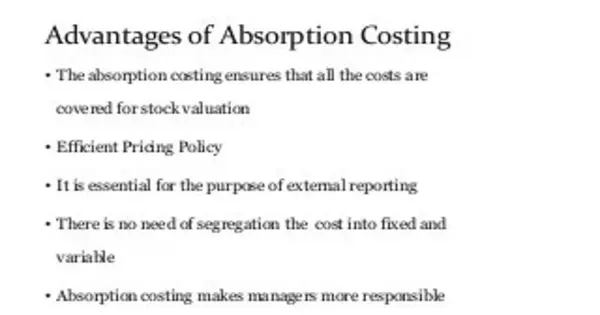Absorption costing is an accounting method that captures all of the costs associated with the production of a specific product. Absorption costing is required in order to file taxes and other official reports. Every manufacturing expense is allocated to all products, regardless of whether every manufactured good is sold. In other words, the company’s products cover all of its expenses.
Using full costing has several advantages. Its main advantage is that it follows GAAP. It is required when preparing financial statements and stock valuation reports.
The main advantages of using absorption costing system are as follows:
Absorption costing incorporates the fixed overheads associated with the manufacturing process into the cost of the product, resulting in a more realistic cost of a product. Furthermore, absorption costing accounts for all production costs, such as fixed costs of operation, factory rent, and factory utility costs. It includes direct costs such as direct materials or direct labor, as well as indirect costs such as the plant manager’s salary or property taxes. It can be useful in determining an appropriate selling price for products.
- Accounting for all production costs
Absorption costing accounts for all production costs, making it a valuable tool for determining appropriate product pricing. This information allows businesses to ensure that the price of their product covers the costs of production. It also allows them to charge more competitive prices in their market.
Absorption costing is the most appropriate method for account preparation. This is the Generally Accepted Accounting Principles-compliant method (GAAP ). The main reason for this is that stock under absorption costing is not undervalued because it accounts not only for the directly attributable expenses (most of which are variable), but also for the fixed manufacturing overheads.
- Tracking profits
Absorption costing provides a more accurate picture of a company’s profitability, especially if all of its products are not sold at the same time. This is an important factor to consider if a company intends to increase production in anticipation of a seasonal sales increase.
When inventory levels rise, absorption costing shows a lower cost of sales and higher revenues for the company than marginal or variable costing. Because the formula for calculating cost of sales is “Opening Stock + Purchases – Closing Stock,” the remaining stock at the end of the year under absorption costing is worth more than the stock reported under marginal costing.
- Suitable for smaller companies
Because small businesses typically do not have a large number of products, absorption costing makes tracking easier. Companies can absorb fixed costs ahead of time and sell their products at a more realistic price and profit margin.
For smaller businesses, absorption costing is the best method of costing. Adoption of absorption costing simplifies calculations for small businesses, as these entities are unlikely to have a large number of products. Furthermore, it enables these businesses to absorb fixed costs ahead of time and sell their products at a more realistic ‘selling price’ as well as profits.
- Suitable for changing demands
Absorption costing is advantageous for businesses that have a consistent demand for their products. Because costs are already fixed to the products, it provides a simple and systematic costing tool for active businesses while accounting for fluctuating turnover.
Absorption costing is a good method for businesses that have a consistent demand for their products. This not only makes costing simpler, easier, and more systematic for such businesses, but it also accounts for the effects of fluctuating turnover because the costs associated with the products are already absorbed in the products.













